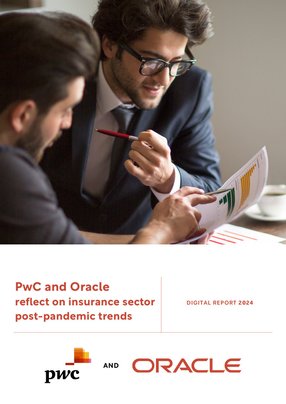PwC and Oracle Reflect on the Insurance Sector Post-Pandemic
Insurance has long held the tagline of being slow to innovate or adopt new technologies, particularly at companies with extensive histories and a mature position in the market.
The rise of B2C insurtechs has helped drive competition in the market – attracting consumers with more streamlined customer experiences and faster claims processing. To survive in today’s fast-paced environment, enterprises need modern financial reporting systems that can quickly integrate high volumes of complex data to inform decision-making and reporting capabilities.
PwC Principals Tony Bowers and Brett Maher, alongside PwC Oracle Alliance Leader Alexis Hall and Oracle Senior Director for Product Management Geetika Chopra, discuss ways industry-leading insurance enterprises are addressing technology transformation in the sector and overcoming the challenges at hand.
Maher has been a Principal in PwC’s Finance Transformation practice for over 11 years, specialising in building more effective finance and accounting organisations for global insurance and financial services companies.
Bowers is similarly experienced. Working at PwC for 11 years, he is a Principal in the Oracle practice and focuses on finance transformation enabled by cloud technologies in the financial services industry.
Hall, the leader of PwC’s US Oracle Strategic Alliance, has over 20 years of experience in technology consulting and helps PwC drive client value through concentrated investments and strategic alignment with Oracle.
They are joined by Senior Director for Product Services at Oracle Financial Services Geetika Chopra.
In her role, Chopra leads product management for insurance analytics, accounting standards, and products for banking and insurance companies.
For our interviewees, it is important to first understand the industry’s macroeconomic pressures and trends before addressing how technology can help manage these pressures and take advantage of the trends.
Global insurance trends in 2023
Over the last few years, perhaps no pressure has been as great as the rising costs in property and casualty (P&C) lines of insurance, driven to unprecedented levels as the rate of claims has increased dramatically. Increases in reinsurance costs and personnel costs have been significant for insurers also.
In the US alone, according to the American Property Casualty Insurance Association (APCIA), there were at least 10 catastrophes in 2021 and 2022, causing more than US$1B in losses for insurers, driving up property catastrophe reinsurance costs. For Maher, it’s clear this points to more risk in the sector, and, therefore, higher claim rates. Inflation has also made these claims more expensive on a relative basis.
He continues: “There are different types of risks now in our world, whether it's cyber risk, which has claims and liabilities associated with it, or the effects of climate change, which is also introducing novel types of risks and opportunities for new products.
“Globally, insurance companies are working with sector authorities and regulators to consider rate increases to cover both the higher volume of claims and the higher expenses associated with these claims.
“On the other hand, we have observed a continuing trend in recent years where P&C organisations are still looking at the small and middle market commercial specialty niche with the potential for outsized performance.”
The trend looks set to continue, with natural catastrophe claims up by around 30% on expected levels in the first half of 2023, according to APCIA, dragging down the broader market.
The issue for, and subsequent pressure on, insurers comes from affordability. Many residents in natcat-prone areas are often unable to afford rising premium costs.
However, while P&C lines may be putting pressure on the global insurance market, rising interest rates in life and annuity (L&A) markets should be helping insurers’ portfolio yields, at least in the short-to-mid-term.
Maher expands: “When it comes to L&A, what’s interesting in the marketplace post-COVID-19 are the high interest rates in the US. The US Federal Reserve started raising interest rates at the start of 2022.
“That was good for investment portfolios, bonds and the ‘vanilla types’ of investments typically made by insurance companies. That’s because such investment income is what's going to be used to pay out annuities, a death claim or a benefit associated with a policy. The benefits of those higher rates may be seen over the next several years.”
“To find new market opportunities, companies are focusing on product customisation in both the L&A and P&C markets. Essentially, insurers are trying to figure out how to get to customers quickly – particularly millennials – through digital products or digital engagement, because that seems to be the way that younger generations want to buy.”
Innovative companies are using customer data such as telematics, internet usage, or other third-party data to tailor products and services to their customers and to help achieve better underwriting results.
As Maher explains: “There is another important driver impacting our clients. With life and annuity products tending to have longer durations than a P&C product, we have seen an increased focus from L&A insurers on capturing higher investment returns to increase profits.
“In turn, that focus has resulted in many private equity firms with large capital positions and investment management platforms participating in the reinsurance market to try to achieve outsized performance over the long run. They get the benefit of investing that money with their investment management capabilities and their unique access to investors with differing investment needs. The combination of scale, access to both public and private capital markets, and additional focus on expenses management is believed to be a winning formula.
“This allows them to get those outsized investment returns to offset liabilities – which are future claims or annuity payouts. Moreover, the overall insurance industry has seen an increased level of activity in reinsurance transactions as companies attempt to optimize their return on capital, expense structure, and effectively manage the assets and liabilities on their balance sheet.”
PwC Principal Tony Bowers expands: “The macro trends for both L&A and P&C continue to present opportunities and challenges for CFO organisations to concentrate on improving their financial planning and analysis (FP&A) capabilities.
“Let’s consider the COVID-19 pandemic, for example. The actuarial tables that life insurers use have not been adjusted in a substantial way since the 1918 Flu pandemic. From a forward-looking perspective, that's going to have a substantial impact on the metric drivers that insurers would use as we think about the FP&A landscape.
Analytics in insurance: A priority for CFOs
In Maher’s view, these macro factors and other market trends in insurance make it a priority for CFOs to be better “partners” to the business.
He expands: “Today insurance CFOs are focused on better informing decision-making. They do so by providing CEOs and business partners with critical financial insights, timely access to information, and both internal and external information to understand the profitability of products. Moreover, the demand for forward-looking analytics and the ability to model different scenarios is at an all-time high.
“At PwC, we meet daily with CFOs of some of the world’s largest insurance companies. In our conversations with life and annuities companies, we emphasise the source of earnings, asking: What are the drivers of earnings - whether it's the underwriting performance, expense management, investment performance, or other financial and non-financial factors? Looking forward, the next question is: How is excess capital best allocated?
“At P&C companies, climate change is making underwriting more difficult. In certain parts of the world, it's hard to get insurance companies to answer the phone and underwrite your risk depending on the required coverage and location. P&C companies rely on crucial business insights to make those decisions, and we’re working with clients to wrangle that data and make it available so that both Actuaries and Finance teams have the information they need.”
The role of CFOs is also to work with P&C business lines to focus on forward-looking scenarios, modeling different outcomes and understanding the impact of potential risks that may not be present today but will be in the future.
What’s more, as a recent PwC survey indicates, CFOs are having to adapt and drive modernisation across the sector. As Bowers puts it, “Leading organizations are investing in insurance software platforms to digitize front-end policy and claim-administration processes, and that has a direct tie-in with finance. Insurers have been very slow to modernise across their platforms, starting with policy and claim systems but also the finance and actuarial areas.
“But on the P&C side, we’ve seen increased modernisation as it relates to customer engagement, as well as buying patterns such as enabling customers to easily bundle products together.
“Today, insurance industry CFOs are no longer looking just at the general ledger. The general ledger doesn't have the data necessary to facilitate the insights that CFOs need.
“In the legacy world of Enterprise Resource Planning (ERP), many insurance companies used the ERP as a ‘catch-all’ and the center of their finance architecture. As Oracle has expanded its products, insurers are now selecting multiple components such as domain specific data warehouses, Accounting rules engines, SaaS ERP, SaaS Enterprise Performance Management (EPM), and other additional capabilities, such as Human Capital Management (HCM) or Configure-Price-Quote (CPQ), to enable more holistic end-to-end architectures that provide expansive data capabilities, better data integration, efficiencies, and even cost-reduction opportunities.”
For Oracle’s Chopra, the shift to modernisation for CFOs comes as a continuation of overcoming International Financial Reporting Standard 17 (IFRS-17) insurance contract regulations, which requires companies to measure contracts using up-to-date estimates that reflect cash flow timings and uncertainty around contracts.
She says: “CFOs who have now overcome the IFRS-17 challenge are seeking to develop key performance indicators (KPIs) that they can use to measure these new metrics.
“Choosing the right KPIs is important because KPIs that insurers previously tracked may not be as relevant moving forward.
“This is where the financial ratios we have been seeing in the industry so far are about to change globally because the language used by the CFO in an insurance company is changing. It's changing alongside shifts in the underlying metrics.
“Many insurers are looking at their systems differently today. They're looking at their data and trying to determine whether they can capture these financial ratios in the manner that is being asked for.
“Eventually, in some countries, there will be requirements to understand how data is flowing in, being stored, and how these calculations are eventually getting reported.”
For Chopra, many insurers – particularly CFOs at insurance companies – are waking up to this new reality and seeing the benefits of cloud transformation within their respective organisations.
The crucial role of data to inform decision-making
Of course, this is just part of the motivation insurance CFOs have for migrating to the cloud. Meeting the requirements of ever-evolving regulations can be made far simpler with cloud-based solutions.
Bowers expands:
“CFOs today should be stewards of data. And, if you go by the regulatory playbook, finance leads the charge in terms of enterprise data and the way organisations are analysing how financial data connects within operations, HR, underwriting, and other various components.
“Because finance and financial departments are so heavily regulated, they tend to have the best standards and the starting point for data and data governance.”
Modernising accounting and financial reporting
Insurers looking to level up their data architectures and operations can leverage Oracle’s Enterprise Data Management Cloud Service, which allows enterprises to immediately store metadata in a defined structure – making best use of this data as it comes to the architecture.
Cloud solutions can help insurers reduce costs associated with the processes needed to keep up with regulatory demands. They provide enhanced scalability, increased capability on a quarterly basis, lower IT operating costs, and increased security.
As put by Bowers: “The beauty of cloud solutions is that they provide enhanced scalability, increased capability on a quarterly basis, lower IT operating costs, and increased security.”
Other products such as Oracle’s Financial Services Advanced Analytics (OFSAA), and the new Financial Services Accounting Foundation Cloud Service (AFCS), ingest data at a granular or policy level of detail that through accounting rules engines, allowing for quick data availability while enabling compliance.
Bowers notes: “With AFCS, Oracle immediately provides the data model necessary to fulfil reporting needs. It's one less thing that insurance CFOs have to think about in terms of trying to figure out which dimensions they must capture. Modernised systems can provide access to alternative data sources with more expansive data models and data consumption capability. Capture of this expanded data enabled advanced analytics as well as provide better support on product launches or other potential revenue sources.
Through its alliance with Oracle and enabled by a team with insurance industry-specific experience, PwC facilitates organisations’ cloud journeys and develops solutions to help businesses meet their transformation goals.
Bowers continues: “We've been working with Oracle for almost 20 years now on the insurance data model and helped to define the original Oracle Insurance Data Foundation layer.
“Over the years, this collaboration has expanded with other clients as new regulations have come in and data models have changed. Our ability to work with Oracle on the front-end has been invaluable for insurers worldwide, making it possible for us to develop together industry-leading solutions that are transforming businesses.
“In fact, PwC developed an accelerator to improve the Oracle Accounting Hub. This accelerator takes more than 250 financial instruments and maps them into the required data specifications, enabling event-based accounting.
“This means that when an insurer sells or adjusts a policy, they're able to feed us that business event, and we extrapolate what the accounting impacts are of that business event.
“So having the Accounting Hub Cloud service from Oracle has been a game-changer to enable that type of capability.”
For Hall, divergence from ERP software has been an important development PwC and Oracle have been able to deliver to clients as well.
She adds: “While ERP remains an important component, having this alongside other capabilities on the front-end, from a data capture and account reporting perspective, gives us the ability to find the solutions for consistent budget allocations.
“CFOs need a data architecture with strong reconciliation capabilities so they can trust their data.
“With Oracle’s Account Reconciliation Cloud Service (ARCS) product, we’re able to provide that insight bundled on top of the overall architecture with Oracle Risk Management Cloud, which enables organisations to meet the US’ Sarbanes-Oxley Act (SOX) rules and other stringent regulations.
“Oracle offers a full suite of end-to-end products to meet the needs of finance professionals and CFOs, and PwC is dedicated to helping our joint customers reach their goals.”
Make sure you check out the latest edition of FinTech Magazine and also sign up to our global conference series - FinTech LIVE 2024
**************
FinTech Magazine is a BizClik brand




- Strategy Shift: Stripe De-Couples Payments From Tech StackDigital Payments
- Exploring Fintech Zilch Following AWS Partner ExpansionDigital Payments
- ComplyAdvantage Acquires Golden for AI Crime InsightsFinancial Services (FinServ)
- Adyen Finds One-Third of Businesses are Victims of FraudFraud & ID Verification


